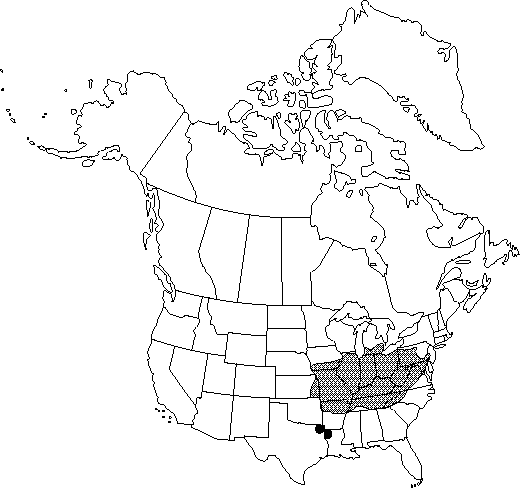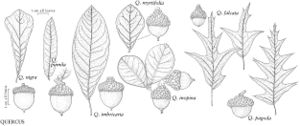Quercus imbricaria
Hist. Chênes Amér., no. 9, plates 15, 16. 1801.
Trees, deciduous, to 20 m. Bark grayish brown, fissures and ridges shallow, inner bark pinkish. Twigs greenish brown to brown, 1.5-3(-4) mm diam., glabrous or sparsely pubescent. Terminal buds brown to reddish brown, ovoid, 3-6 mm, distinctly 5-angled in cross section, scales minutely ciliate on margins. Leaves: petiole 10-20 mm, glabrous. Leaf blade ovate or elliptic to obovate, usually widest near middle, 80-200 × 15-75 mm, base obtuse to cuneate, occasionally rounded, margins entire with 1 apical awn, apex acute to obtuse; surfaces abaxially uniformly pubescent, adaxially lustrous, glabrous. Acorns biennial; cup deeply saucer-shaped to cup-shaped, 5-9 mm high × 10-18 mm wide, covering 1/3-1/2 nut, outer surface puberulent, inner surface light brown to reddish brown and glabrous or with a few hairs around nut scar, scale tips tightly appressed, acute; nut ovoid to subglobose, 9-18 × 10-18 mm, often striate, having 1 or more indistinct rings of minute pits at apex, glabrate, scar diam. 5-9 mm. 2n = 24.
Phenology: Flowering spring.
Habitat: Moderately dry to mesic slopes and uplands, occasionally in ravines and bottoms
Elevation: 100-700 m
Distribution

Ark., Del., D.C., Ill., Ind., Iowa, Kans., Ky., La., Md., Mich., Mo., N.J., N.C., Ohio, Pa., Tenn., Tex., Va., W.Va.
Discussion
The wood of Quercus imbricaria was once an important source of shingles, hence its common name.
The Cherokee used the bark of Quercus imbricaria to treat indigestion, chronic dysentery, mouth sores, chapped skin, general sores, chills and fevers, lost voice, milky urine, and as an antiseptic and a general tonic (D. E. Moerman 1986).
This species reportedly hybridizes with Q. coccinea (W. H. Wagner Jr. and D. J. Schoen 1976); with Q. falcata (producing Q. ×anceps E. J. Palmer) and Q. ilicifolia (D. M. Hunt 1989); with Q. marilandica, Q. palustris, and Q. phellos (H. A. Gleason 1952); and with Q. rubra, Q. shumardii, and Q. velutina.
Selected References
None.
